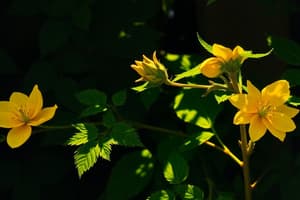Podcast
Questions and Answers
What is the main function of stomata in plants?
What is the main function of stomata in plants?
- To absorb water and minerals from the soil
- To regulate gas exchange and control water loss (correct)
- To support the plant's structure and balance
- To produce glucose and oxygen through photosynthesis
What is the difference between autotrophs and heterotrophs?
What is the difference between autotrophs and heterotrophs?
- Autotrophs produce their own food, while heterotrophs consume other organisms (correct)
- Autotrophs consume other organisms, while heterotrophs produce their own food
- Autotrophs are multicellular, while heterotrophs are unicellular
- Autotrophs are found in plants, while heterotrophs are found in animals
What is the function of the stem in a plant?
What is the function of the stem in a plant?
- To absorb water and minerals from the soil
- To produce glucose and oxygen through photosynthesis
- To regulate gas exchange and control water loss
- To support the plant's structure and facilitate conduction, photosynthesis, and storage (correct)
What is the primary function of roots in a plant?
What is the primary function of roots in a plant?
What is the function of chloroplasts in plants?
What is the function of chloroplasts in plants?
What is the difference between unicellular and multicellular organisms?
What is the difference between unicellular and multicellular organisms?
What is the primary function of tissues in the body?
What is the primary function of tissues in the body?
What is the process by which cells become specialized for a specific function?
What is the process by which cells become specialized for a specific function?
What is the term for a group of functionally related organs?
What is the term for a group of functionally related organs?
What is the term for cells that have the potential to form many other cells?
What is the term for cells that have the potential to form many other cells?
Flashcards are hidden until you start studying
Study Notes
Autotrophs and Heterotrophs
-
Autotrophs obtain glucose through self-manufacture via photosynthesis, producing their own food.
-
Autotrophs use energy from the sun to convert water and carbon dioxide into glucose.
-
Glucose gives plants energy and is used to make cellulose for growth and cell walls.
-
Heterotrophs obtain organic nutrients by consuming autotrophs or other heterotrophs.
-
Heterotrophs rely on autotrophs and other organisms for nutrition.
Plant Structures
Roots
- Anchor the plant, transport water, minerals, and sugars, and store excess nutrients.
- Function similar to our feet, helping the plant balance.
Stem
- Functions in support, conduction, photosynthesis, and storage.
Leaves
- Organs of the shoot system adapted for photosynthesis.
- Contain chloroplasts and stomata for gas exchange.
Gas Exchange
- Plants exchange gases through stomata (tiny pores) on the underside of leaves.
- Guard cells regulate stomatal opening and closing.
- Animals exchange gases through specialized respiratory organs (e.g., lungs, gills, skin).
- Cells in both plants and animals perform respiration.
Unicellular and Multicellular Organisms
- Unicellular organisms consist of one cell only.
- Examples: Amoeba, Paramecium.
- Multicellular organisms consist of multiple cells.
- Examples: humans, animals, plants.
- Cells need to communicate and coordinate to function properly.
Tissues and Organs
- Tissue: a collection of cells that perform the same function.
- Examples: muscle, nerve, connective, epithelial tissue.
- Organ: a structure that contains more than one type of tissue working together.
- Examples: heart, stomach, brain.
- Organ system: a group of functionally related organs.
- Examples: digestive system, circulatory system.
Hierarchical Structure of Organisms
- Cells: the basic unit of structure and function in living organisms.
- Cells perform various functions, such as growth, metabolism, and reproduction.
- Organelles: specialized structures within cells.
- Examples: chloroplasts, mitochondria, ribosomes.
- Tissues: a collection of cells that perform the same function.
- Examples: muscle, nerve, connective, epithelial tissue.
- Organs: a structure that contains more than one type of tissue working together.
- Examples: heart, stomach, brain.
- Organ systems: a group of functionally related organs.
- Examples: digestive system, circulatory system.
Stem Cells and Differentiation
- Stem cells: cells that have the potential to form many other cells.
- Can be totipotent, pluripotent, or multipotent.
- Differentiation: the process by which cells become specialized for a specific function.
- Involves the expression of specific genes and the formation of specialized structures and organelles.
Gas Exchange in Plants
- Stomata: tiny pores on the underside of leaves that allow for gas exchange.
- Regulated by guard cells.
- Photosynthesis: the process by which plants convert sunlight into chemical energy.
- Occurs in chloroplasts and requires carbon dioxide and water.
Leaf Structure and Photosynthesis
- Leaf structure: includes the cuticle, upper epidermis, palisade mesophyll, spongy mesophyll, and lower epidermis.
- Each layer has a specific function, such as reducing water loss or capturing light for photosynthesis.
- Photosynthesis: occurs in chloroplasts and requires light energy.
- Produces glucose and oxygen as byproducts.
Plant Structure and Function
- A leaf's structure is adapted to increase light absorption and carbon dioxide diffusion.
- Large surface area to increase light absorption.
- Thin to minimize distance for carbon dioxide diffusion.
- Chlorophyll absorbs sunlight and transfers energy into chemicals.
- A network of veins supports the plant and carries water and carbohydrates.
- Stomata (pores mainly located on the underside of the leaf) allow carbon dioxide to diffuse into the leaf.
- Leaf adaptations: thin, transparent epidermis to allow more light...
Studying That Suits You
Use AI to generate personalized quizzes and flashcards to suit your learning preferences.




